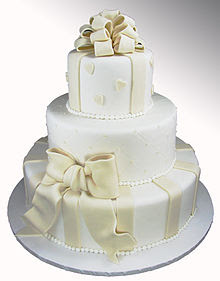Fondant
The smooth, almost flawless icing seen on many traditional wedding cakes is fondant. Depending on the type of fondant, it can be rolled and draped over a cake or poured over a cake as a liquid. Fondant gives a cake a smooth, professional appearance, keeps the cake moist longer, and provides a distinctive flavor and texture.
Fondant is difficult to make correctly. The sugar mixture must be heated and cooled very precisely so that, as the fondant cools, tiny crystals are formed. These tiny sugar crystals give the fondant its smooth, silky appearance. If the sugar is heated too much, the fondant will become dull and gritty.
Fondant also requires a specific ratio of either glucose or cream of tartar when it is made. With too much of these ingredients, the fondant stiffens and becomes difficult or impossible to work. A fondant without enough glucose or cream of tartar will remain liquid and will not reach the dough-like consistency necessary for proper frosting.
For these reasons, most bakers buy pre-made fondant from craft stores or baking supply stores. Pre-made fondant comes ready to use in a sealed container, or it can be purchased in powdered form. The ready-to-use fondant is quicker and easier, but must be used sooner after purchase. The dried fondant must be hydrated before use, but stores better.
Icing a cake with fondant can be a tricky process, but is not difficult with a little practice. First, the cake should be coated with a light fruit glaze or a thin layer of marzipan or buttercream frosting. The glaze or frosting will help in two ways. First, it gives the cake a smooth surface for the fondant, preventing crumbs from making the fondant appear lumpy. Second, the frosting forms a layer between the cake and the fondant, preventing the cake from pulling the moisture out of the fondant and making it appear dry.
With the smooth layer of frosting or glaze on the cake, you are ready to apply the fondant. If you are using poured fondant, start in the center of the top of the cake and slowly pour your fondant so that it flows over the top and down the sides, using a knife or spatula to direct and smooth the fondant.
For rolled fondant, use powdered sugar to coat the rolling pin and work area. Roll the fondant into a thin, flat sheet large enough to completely cover the cake. When the fondant is rolled out to size, loosely roll it onto the rolling pin and carefully drape it over the cake. Be careful not to pull the fondant across the cake, or the fondant may tear. When you have the fondant in place, smooth the sides of the cake, and using a sharp knife, cut away any excess fondant around the bottom.
Fondant is an elegant, beautiful frosting. Not just for wedding cakes any more, fondant can be seen on cakes for all occasions, made both by professional bakers and amateur chefs at home. If you're baking a cake, you might consider fondant as a fun, new way to frost it.
Source: FONDANT



Comments
Post a Comment